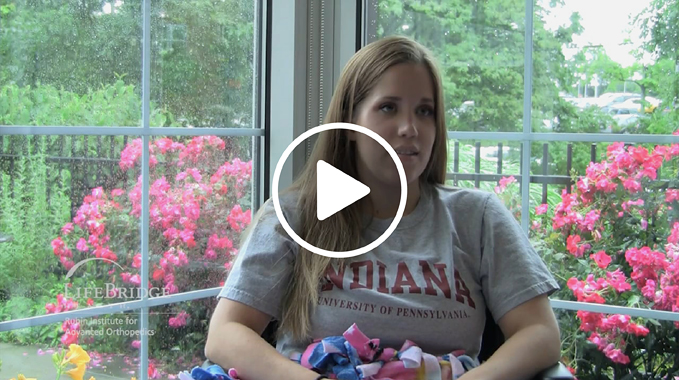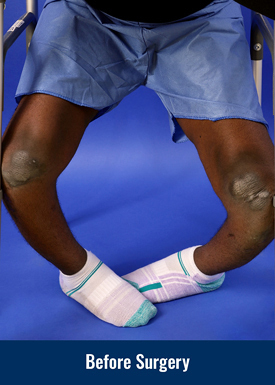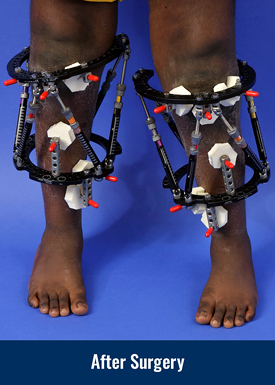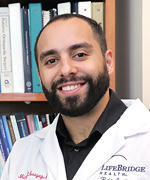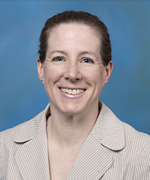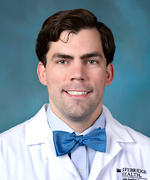Bowlegs
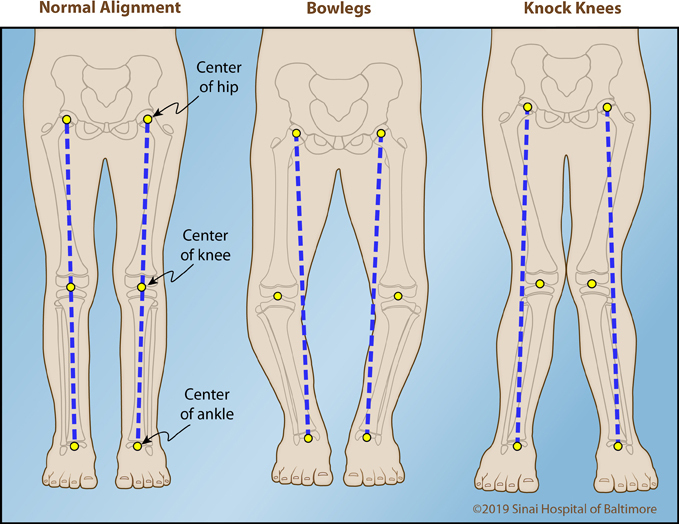
What are bowlegs?
Bowlegs are legs that curve outward at the knee, keeping the knees apart even when the ankles are together. To understand bowlegs, also called genu varum, it is important to first understand “normal” alignment of the legs. In the normal situation, when standing, the hips, knees and ankles all fall on a straight line. In other words, when you draw a line from the hip to the ankle, that line passes directly through the center of the knee. If that line passes to the inside of the knee (internally), this is called bowlegs (varus deformity). If that line passes to the outside of the knee (externally), this is called knock knees (valgus deformity).
Video: Leg-Straightening: A Patient’s Story
The International Center for Limb Lengthening successfully treats children and adults with bowlegs on a regular basis.
Click here to skip to Adults and Bowlegs.
Children and Bowlegs
A large number of the children we see have “physiological” bowlegs, which are completely benign and do not need treatment. These bowed legs gradually correct on their own and usually are totally resolved by the age of 5 years. These children usually have mild and symmetrical bowlegs.
When will a doctor suspect a pathological cause of bowlegs in children?
The doctor may suspect a pathological cause in case of bowlegs if one or more of the following is present:
- Severe bowing
- Unilateral bowing (occurring only in one leg)
- Short stature
- Obesity
- Above the age of 2
What causes pathological bowing in children?
Pathological bowing is caused by:
- Trauma or infection
- Blount disease
- Rickets
- Skeletal dysplasia
- Tibial hemimelia (shortened or absent shinbone).
How is bowlegs diagnosed in children?
In case of suspecting a pathological cause, the doctor may run some investigations including lab work and X-rays to reach a diagnosis.
How is bowlegs treated in children?
The aim of treatment will be to correct limb alignment, stop disease progression and prevent expected post-treatment recurrence.
- I. Orthotics
- Custom molded braces may be effective in mild cases of Blount disease or rickets, but they are not tolerated by all children. Treatment may last up to 18 months.
- II. Surgical Correction
- A) Hemiepiphysiodesis temporary arrest (guided growth)
There are growth plates in the end of long bones that are responsible for adding bone length as the child grows. Slowing the growth process on one side of this growth plate can give a gradual correction of the bowing as the child grows. The procedure is done with a small plate and two screws that straddle the growth plate. The procedure is simple, with minimal incision and blood loss, and it is reversible. Correction occurs gradually and may take 6-12 months. The child will be able to walk right after the procedure. No casts or braces are needed.
- B) Gradual correction using external fixators
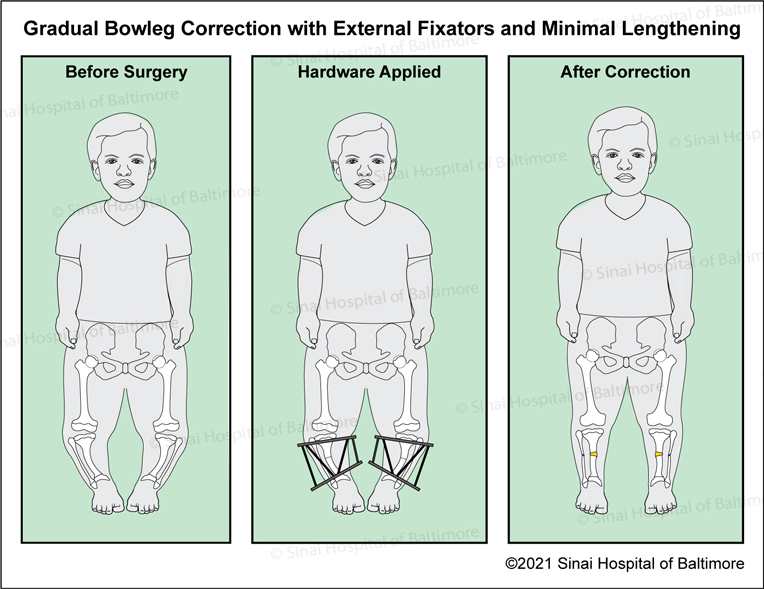
The bowed legs can be corrected gradually using an adjustable frame. In the operating room, the surgeon cuts the bone (osteotomy) and applies an adjustable external frame to the bone with wires and pins. The parents receive a regimen outlining the daily adjustments that should be made to the frame. The child walks, sleeps, bathes and does all daily activities with the frame on without feeling pain. The bone gradually heals in the corrected position, and the family visits the doctor every few weeks to make sure that everything is going as planned. Based on the follow-up X-rays, the doctor may revise the schedule to achieve better results. After correction, the patient will have to be admitted to the hospital to remove the frame. For more details, please see our page on the process of deformity correction.
- C) Acute osteotomy
The bone is cut and full correction is done in the operating room. The patient will typically have a plate with screws inserted internally to stabilize the cut bones and will be put in cast for a period of 6 to 8 weeks until the bone unites. The patient will not be allowed to walk during this period to ensure the correction will not be lost. For more details, please see our page on the process of deformity correction.
- A) Hemiepiphysiodesis temporary arrest (guided growth)
Which treatment plan is best for my child?
Each treatment plan is individualized and based on many factors:
- the nature of the disease and its tendency to progression,
- the severity of the disease,
- the age of the child,
- the presence of shortening requiring lengthening, and
- an abnormality or depression in the knee joint line.
All of these factors will inform the surgeon’s recommendation.
Adults and Bowlegs
In adults, bowlegs do not resolve spontaneously, but rather tend to worsen as arthritis leads to further malalignment. Bowlegs in adults is an independent risk factor for knee joint degeneration and pain. Multiple studies have shown that correction of bowlegs prior to the onset of end stage arthritis can delay or prevent the need for total knee replacement.
How is bowlegs diagnosed in adults?
While clinical examination is helpful, the standard diagnostic method is a standing-alignment X-ray.
How is bowlegs treated in adults?
The aim of treatment will be to correct limb alignment, stop disease progression and reduce the risk of further joint degeneration.
- I. Acute osteotomy
- The bone is cut and full correction is done in the operating room. The patient will typically have a plate with screws inserted internally to stabilize the cut bones and will be non-weightbearing for a period of 6 to 8 weeks until the bone unites.
- II. Gradual correction using external fixators
- The bowed legs can be corrected gradually using an adjustable frame. The surgeon cuts the bone and connects an adjustable external frame to it with wires and pins. A regimen is prescribed that outlines the daily adjustments that should be done to the frame. The patient walks, sleeps, bathes and does all daily activities with the frame in place. The bone gradually heals in the corrected position, and the patient visits the doctor every few weeks to make sure that everything is going as planned. Based on the follow up X-rays, the doctor may revise the schedule to achieve better results. After correction, the frame will need to be removed in the operating room.
Which treatment plan is best for me?
Each treatment plan is individualized and based on many factors:
- the nature of the disease and its tendency to progression,
- the severity of that disease,
- the presence of shortening requiring lengthening,
- an abnormality or depression in the knee joint line, and
- your patient preference.
All of these factors will inform the surgeon’s recommendation.
Why choose the International Center for Limb Lengthening for treatment of bowlegs?
The International Center for Limb Lengthening is world-renowned for its expertise in limb deformity correction. Your doctor at the International Center for Limb Lengthening will take the time to make sure you understand all your options and then will customize your treatment to meet your specific needs. Our patients benefit from our team-centered approach with world-renowned pediatric and adult orthopedic surgeons and specialized physician assistants, nurses and physical therapists. We help patients with bowlegs achieve their best possible result.
Chat with a doctor about bowlegs
Our doctors hold free monthly chats on various subjects, including bowlegs. Click here for more information about our monthly chats.
